No, the whole frame actually has noise. It's just more noticeable on solid colors like the red background, or the white suit and shirt. There should be no movement on the red background. Yet if you step through the frames, the red pixels look like they are jumping around and changing to different shades of red. This is why I use convolution3D to smooth this all out. I bet if you watch the analog tape on TV, and step through frames, you don't see this "noise".Originally Posted by edDV
+ Reply to Thread
Results 31 to 37 of 37
-
-
I agree the convolution3D filter would smooth the noise (after IVTC). This was recorded direct off the analog cable channel. Noise is always visible on the live channel.
I just pulled that clip more or less at random. Too bad the 'focus puller' couldn't keep the woman in focus. -
For those unfamiliar with the inverse telecine (IVTC) process for film sources, here is a simple pass through VirtualdubMod to convert the 720x480i/29.97fps video back to 23.976fps RGB.
1. Load the dscchsample1.avi above into VirtualDubMod
2. Under "Video" "Frame Rate" choose "reconstruct from fields - adaptive"
3. Save as dscchRGB24.avi
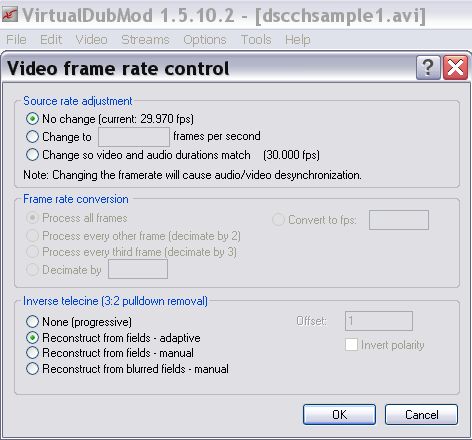
The original 480i DV-AVI file will be decompressed, converted to RGB (default) and be reverse telecined to 23.976fps. Since we are limited to 2MB files here, I can't post the finished file. You will have to make your own. It grows to over 5x the size in the conversion from 4:1:1 YUV 29.97fps to 4:4:4 RGB 23.976fps.
Next RGB filters could be applied such as noise reduction or color correction.
When you examine both files, you will see that the first 3 frames are progressive with both fields coming from the same original film frame.
Frame 1

Frame 2

Frame 3
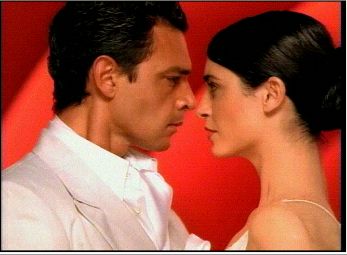
Frame 4 will be constructed from one field from each of the next two telecined frames.
 and
and 
To make frame 4
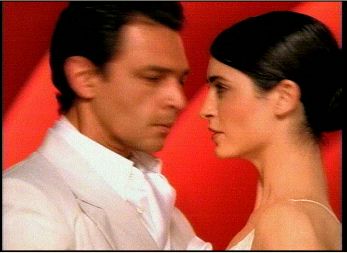
The next 3 frames will be progressive.
Frame 5
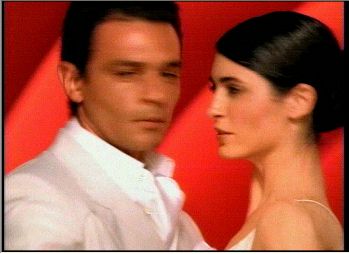
Frame 6
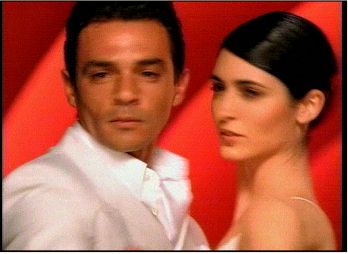
Frame 7

Then in a similar way to frame 4, frame 8 is constructed from the next two telecined frames and so on ...
Frame 8

For more detail on telecine see this link
http://www.dvdfile.com/news/special_report/production_a_z/3_2_pulldown.htm
http://neuron2.net/LVG/telecining2.html -
But this is retouching the video after capturing it isn't it? can I get good video off the VHS without needing the pc retouch my videos to remove color excess etc... I have a Mitsubishi HS-U500 VCR is that good enought for a source?
-
Removing telecine is not retouching but is a necessary first step for advanced filtering or progressive playback. All that is happening when film frames are telecined for NTSC is the fields are displayed or repeated in a different order to change frame rate from 23.976 to 29.97. This is true for any film based video recorded to a NTSC VCR or capture card. The padded fields will look like this when played back. The fields you see here are from two different film frames 1/24 sec displaced. That is why they both appear to have two ears on one side of their head.Originally Posted by CCEncoder

When played back at 1x 29.97 fps speed, you see reasonably smooth video, but when filters work on a frame, they are seeing mixed frames like shown above for two out of every 5 frames. Inverse telecine just reorders the fields back to 23.976 progressive so that full frame filtering can be applied. It also gives the option to either author a progressive DVD or you can re-encode interlace for a telecined DVD. This is true for all NTSC capture cards and isn't unique to the ADVC.
If all you want to do is capture NTSC and author an interlace DVD, you do not need to take this step. Just understand the mixed frames are normal and will look strange in step frame mode.
Anyone viewing video with a computer monitor or a plasma/LCD TV needs to understand that this inverse telecine process should be done (by the TV ideally) to look right on a progressive display. That is why "cinema mode" (inverse telcine) is such an important feature for a progressive TV or progressive DVD player. It explains why NTSC films look so bad on a progressive display. 1080i/29.97fps HD sources also telecine in the same way so the issue isn't limited to NTSC. -
Yes, but the only problem with this is the fact that *most* sources that seemAnyone viewing video with a computer monitor or a plasma/LCD TV needs to understand that this inverse telecine process should be done (by the TV ideally) to look right on a progressive display. That is why "cinema mode" (inverse telcine) is such an important feature for a progressive TV or progressive DVD player. It explains why NTSC films look so bad on a progressive display. 1080i/29.97fps HD sources also telecine in the same way so the issue isn't limited to NTSC.
Telecined, are in fact edited telecined*, and this is what causes IVTC failure
or helps to explain why progressive displays suck *during this conversion* though
even non-progressive displays, the process results just suck.
* What I'm saying here, is this.. that the source (once telecined) under'goes
video editing. And its this editing inside the telecine (3:2 patterns) that
is edited. This is not the time to edit a source, but rather at the Progressive
stage, before the start and finished telecine.
And, the only real benefit of real-time IVTC (for any setup situation) is when
the source is ALL clean telecine. I'm sure you know this, but others may not.
By the way, I'm glad that you included the samples from analog sources. I've
being wanting to see others (from ADVC, etc) to examine the noise from this
source medium. I am happy that what I have (from analog) that your's is the
same, too -- Chroma Crosstalk, or ... to be exact. I think that this can be fixed,
but I'm still researching a method, via software coding. Anyways, VHS seems to
be similar in noise content. I wonder how the two relate
And, if the two relate, by not the same, when the source is satellite. Oh well.
Maybe for another topic. I was just thinking out loud what was on my mind for
quite some time now
Cheers,
-vhelp 4102 -
I think the problem you are referring to comes when one assumes a particular 2:3:2:3 reverse telecine cadence will remain fixed through the full program and you are right in most cases the cadence is broken by edits during the program. Certain continuous movies like on HBO or AMC may hold cadence from start to end but other movies, TV series or even a commecial like above may have edits that break the cadence.Originally Posted by vhelp
The problem comes with reverse telecine software like VirtualDubMod above when in "reconstruct from fields - manual" mode where a cadence assumption is made once and there is no adaption to a cadence edit. If IVTC is out of sync, the result is worse than no IVTC at all and this will also ruin full frame filtering unless the IVTC errors are flagged and corrected.
When in post production mode, the burden is on the editor (that is us) to review the IVTC for errors prior to filtering and encoding. It's all about quality control in the final encoded product.
TV set and DVD player deinterlacers have a somewhat more relaxed duty. Any errors in the reverse telecine + chained filters (e.g. noise reduction, picture levels correction or resolution scaling) affect only that instantaneous display. It doesn't get encoded into the tape or DVD as it does in post production.
That said the TV/DVD player deinterlacer has to work in a fully adaptive mode (including small block or pixel level motion detection) because it will have everything thrown at it and needs to implement functions based on what it detects. Among the auto fuctions are:
1. "Cinema" cadence detection (reverse telecine) including recovery from cadence discontinuity. It needs a recovery strategy when breaks in cadence are detected. One simple tactic is to switch to single field mode until the cadence detection is stable. If no film cadence is detected, it will switch into normal interlace mode, or attempt a different deinterlace strategy. Fancy deinterlacers will do pixel level motion analysis and adaptively apply bob or frame average to low motion areas of the picture and field mode to fast motion areas or some similar strategy.
2. The same motion detection can drive noise reduction where low motion areas get the bulk of noise cancelleation and edges are anti-aliased. Residual subcarrier noise from NTSC or PAL decoding can be detected and removed. These technologies are coming down from high end broadast deinterlacers as the patents can be implemented in affordable chips and local frame buffers.
3. For progressive displays, scaling follows input deinterlace. Once the picture is progressive and noise reduced, up or down scaling is relatively simple. Some higher end 1080p strategies apply enhancement tricks such as making low motion edges appear sharper. 24p frames are repeated 3:2:3:2 to get up to low flicker 59.94 frames per second. 50Hz progressive displays will repeat 24p frames 2x or 4x (to near 100Hz) for low flicker.
Similar Threads
-
Macrovision and Canopus ADVC 110
By nikgelfi in forum Capturing and VCRReplies: 2Last Post: 13th Apr 2011, 17:09 -
Canopus ADVC-100 vs Canopus ADVC-110
By tarrickb in forum Camcorders (DV/HDV/AVCHD/HD)Replies: 20Last Post: 16th Oct 2010, 21:52 -
Canopus ADVC 110 Possible problem?
By Drexter in forum Capturing and VCRReplies: 4Last Post: 20th Feb 2010, 22:10 -
Canopus ADVC 110/300 - These Questions have been asked before but I can't..
By Anonymous4 in forum Capturing and VCRReplies: 9Last Post: 21st Nov 2008, 19:14 -
Is Canopus 50/55/100/110 REALLY god's gift to the VHS-capture universe?
By miamicanes in forum Capturing and VCRReplies: 40Last Post: 27th Nov 2007, 15:17




 Quote
Quote